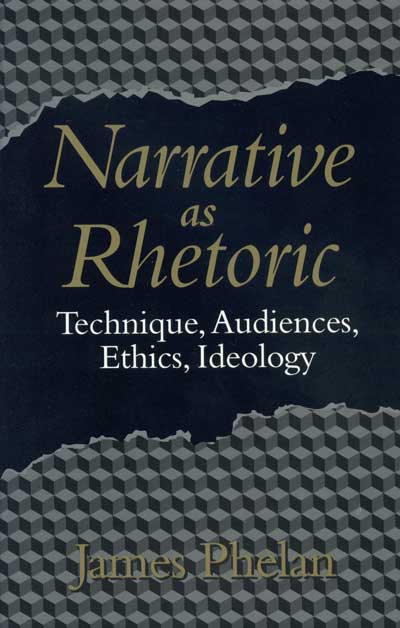| click here to read the complete text of the book | leave / read comments and critiques of the book |

Narrative as Rhetoric
Technique, Audiences, Ethics, Ideology
James Phelan
In Narrative as Rhetoric, James Phelan explores the consequences for narrative theory of two significant principles: (1) narrative is rhetoric because narrative occurs when someone tells a particular story for a particular audience in a particular situation for some particular purpose(s); (2) the reading of narrative is a multidimensional activity, simultaneously engaging our intellects, emotions, ideologies, and ethics.
Narrative as Rhetoric consists of ten essays, each of which explores these principles in connection with interpretative problems posed by one of the following narratives: William Makepeace Thackeray's Vanity Fair, Virginia Woolf’s The Waves, Ernest Hemingway’s A Farewell to Arms and “My Old Man,” F. Scott Fitzgerald's The Great Gatsby, Joseph Conrad’s The Secret Sharer, Lorrie Moore’s “How,” Dinesh D’Souza’s Illiberal Education, and Toni Morrison’s Beloved.
The rhetorical theory of narrative that emerges from these investigations emphasizes the recursive relationships between authorial agency, textual phenomena, and reader response, even as it remains open to insights from a range of critical approaches—including feminism, psychoanalysis, Bakhtinian linguistics, and cultural studies. The rhetorical criticism Phelan advocates and employs seeks, above all, to attend carefully to the multiple demands of reading sophisticated narrative; for that reason, his rhetorical theory moves less toward predictions about the relationships between techniques, ethics, and ideologies and more toward developing some principles and concepts that allow us to recognize the complex diversity of narrative art.
Written with clarity and flair and experimenting at times with the conventions of critical writing, this collection, which includes some of Phelan's best work, is itself audience oriented. The book includes an appendix that is in part an experiment with voice, and it ends with a helpful glossary of the technical vocabulary of narrative theory.
James Phelan is professor and department chair of English at The Ohio
State University. He is the author of Beyond the Tenure Track, and
Reading
People, Reading Plots, among others. He is the co-editor of
Understanding
Narrative.
| 1996 237 pp. | This title is no longer available in a traditional print edition. Click here for free access to the book's full text. |
| Theory and Interpretation of Narrative |

